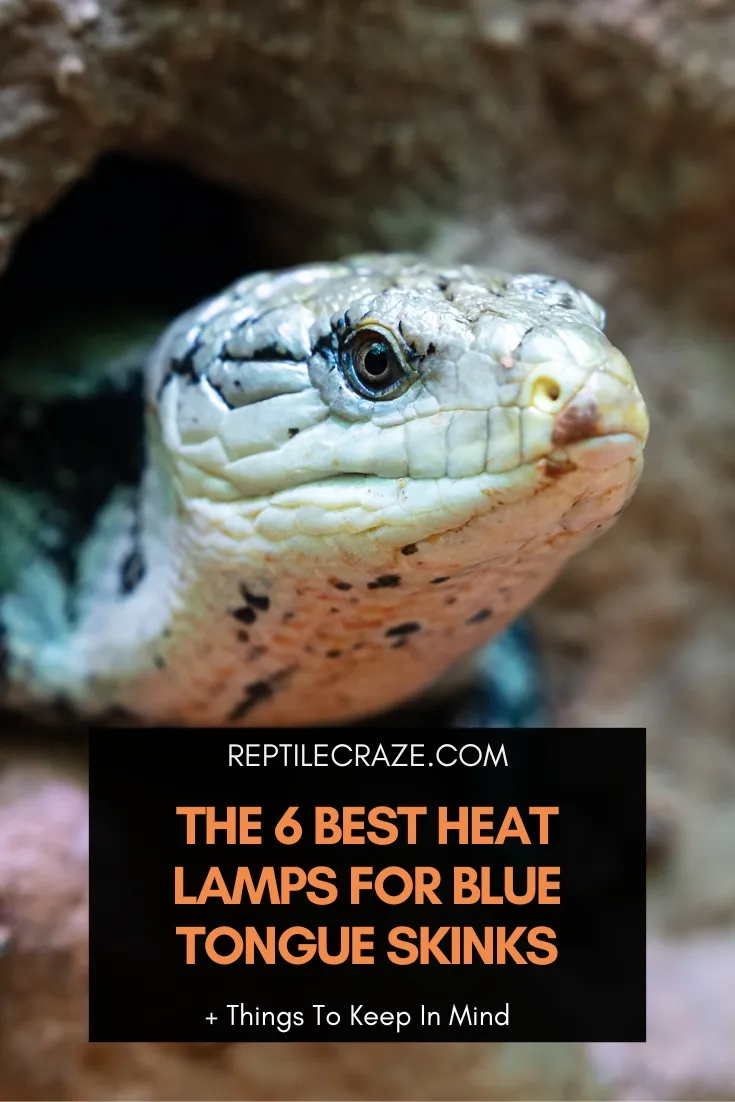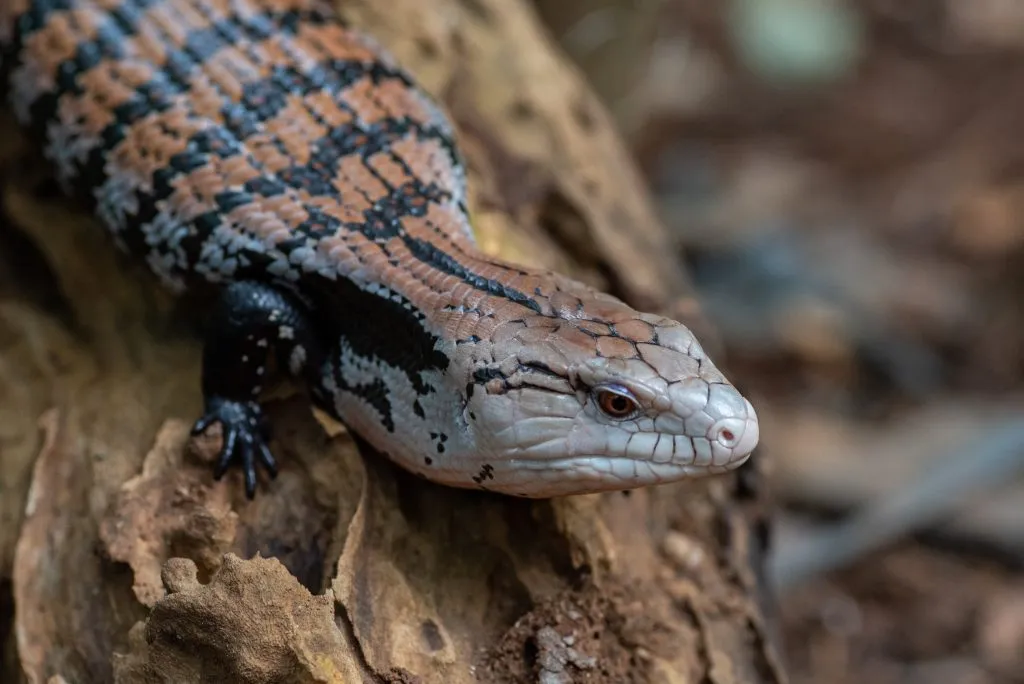
Blue tongue skinks are diurnal reptiles that require a lot of light to trigger their daytime activities as well as ample heat to aid in metabolism and thermoregulation. It can be a bit tricky to find the best heat lamp for your blue tongue skink as you need to find the balance between heating and UVB.
In this article, we are going to discuss the best heat lamps for blue tongue skinks. We will go through the pros and cons of each heat lamp, depending on your planned enclosure set up and we will also give you some alternative heat lamp options.
Table of Contents
Best Heat Lamps For Blue Tongue Skinks
- Best Overall: Repti Zoo Reptile Heat Lamp
- Best 3-in-1 Heat Lamp: Exo Terra Solar Glo
- Best Budget Option: Fluker’s Basking Bulb
- Most Durable Heat Lamp: MCLANZOO Heat Lamp
- Best Lighting: Lucky Herp Reptile Heat Lamp
- Best Solar Glo Alternative: Zoo Med Powersun
Why Buy A Heat Lamp For Blue Tongue Skinks
Blue tongue skinks need warmth in order to thermoregulate. As they cannot produce their own body heat, they rely on their surroundings to provide them warmth in order to do certain activities.
In the wild, blue tongue skinks bask under the sun early in the morning to get the energy to forage for
As it gets cooler, the blue tongue skink goes back to its hide to rest or sleep.
Heat is also necessary for blue tongue skinks to metabolize properly. Both heating and UVB lighting play a crucial role in the proper absorption of calcium in blue tongue skinks.
Reviews Of The Best Heat Lamps For Blue Tongue Skinks
Let us take a look at the heat lamps that will make your blue tongue skink happy. Please note that these bulbs will need a fixture with a ceramic socket as they tend to get quite hot.
This fixture comes in two sizes and all recommended bulbs will fit in it.
1. Repti Zoo Reptile Heat Lamp
The Repti Zoo Reptile Heat Lamp is beloved by many bluey owners due to the soft light that it emits. This assures that the light will not hurt the eyes of our blueys.
What is unique about this lamp is its flat bottom shape. Due to its shape, it can produce about 35% more light and heat compared to other reptile bulbs. It also operates quietly so your blueys will not be stressed by any buzzing noise.
This bulb does not emit UVB, so you need to purchase a separate bulb for that.
Pros
- Bright soft light does not hurt bluey’s eyes
- Consistent heat output
- Energy efficient
Cons
- Some owners experienced burnout after 5 to 6 months
- The aluminum coating at the top of the bulb is sensitive to water
- Does not have UVB
2. Exo Terra Solar Glo
The Exo Terra Solar Glo is a heat lamp that provides visual lighting, heating, and UVB lighting. Therefore, you have everything you need to set up the lighting and heating requirements of your blue tongue skink.
In our full review here, we found out that it has a good heat output. We were also able to measure the UVI and it was determined that you can easily create different Ferguson zones using this bulb.
Ferguson Zone 2 is where blue tongue skinks belong, and it can be achieved easily by using this bulb.
Pros
- Has everything you need for lighting and heating
- Easy to set up
- Has good UVB output
Cons
- You need to replace the bulb every 6 months as it emits UVB
- Can only be used vertically as mercury vapor bulbs tend to give out when set at an angle
3. Fluker’s Basking Bulb
It may come as a surprise that this affordable heat lamp can produce enough heat for a large enclosure as that of a blue tongue skink. The heat output of this bulb is strong enough to concentrate heat directly on the basking spot but also provide ambient heat in other parts of the enclosure.
The bulb gets warm fast and some people were able to use this directly on top of a metal screen without any issues. However, this does not emit UVB.
Pros
- Affordable
- Strong heat output
- Lights up instantly when turned on
Cons
- Tends to burn out quicker compared to other bulbs
- Does not have safeguards for overheating
4. MCLANZOO Heat Lamp
The MCLANZOO Heat Lamp is a halogen bulb that provides consistent UVA and heat but also saves on power consumption. Due to the nature of the bulb, you cannot use it with dimmers, rheostats, and thermostats.
It produces a bright white light and can easily heat a 40-gallon
Keep in mind that it does not emit UVB. It also fits a standard E26/E27 socket.
Pros
- Energy efficient
- Durable
- Good heat output
Cons
- Does not heat up fast
- Does not emit UVB
- The bulb cannot be used with dimmers, rheostats, and thermostats
5. Lucky Herp Reptile Heat Lamp
If you are looking for a heat lamp that can perfectly simulate the light of natural sunlight, then the Lucky Herp Reptile Heat Lamp is perfect. It also provides consistent heating for the enclosure.
They recommended replacing the bulb every 3 months which is considered a shorter period compared to our other recommended bulbs.
However, as some owners have noted, the quality of the light diminishes with every use, even if this bulb does not emit UVB.
Therefore, after the 3rd month, the light may not simulate sunlight as well as it was supposed to during the first use.
On the other hand, the heating component of the bulb remains unchanged. This fits an E26 socket and also needs a ceramic lamp fixture.
Pros
- The light that it emits mimics natural sunlight
- Consistent heat
- Affordable (a pack usually comes with two bulbs)
Cons
- You need to change bulbs every 3 months (as recommended by the manufacturer)
- Does not have UVB
6. Zoo Med Powersun
In our full review here, we found out that the Zoo Med Powersun can be a good source of lighting, heating, and UVB. We branded it as a good alternative to the Solar Glo due to its heat output that is a bit lower.
On the other hand, it is still a good choice for a heat lamp if you pair it with a supplemental heating device.
The light that it emits is a bright yellow light. It also has nickel-plated threads that help prevent the corrosion of your fixture.
Pros
- Provides consistent heat output
- Durable
- Has UVB
- Long-lasting despite emitting UVB (UVB output is good for one year)
Cons
- Heat output is a bit weak compared to other 100-watt bulbs
- Should be mounted vertically as mercury vapor bulbs tend to give out when set up on an angle
Do Blue Tongue Skinks Need UVA and UVB?

Blue tongue skinks can partly see UV light. So they need UVA as part of their color vision. UVB on the other hand is also needed because this paves the way for them to produce Vitamin D3 which is essential to calcium absorption.
Without UVB, your blue tongue skink may develop Metabolic Bone Disease which can be hard to treat and may also result in their death.
How Many Watts Should A Heat Lamp Be For Blue Tongue Skinks
For a standard 40-gallon
It is possible for a 100-watt bulb to still underheat the
Therefore, no matter what wattage of the bulb you have, you still need to measure the heat output by using an infrared thermometer to actually know for sure if the
Tip: If you want to know what temperatures blue tongue skinks need and how to reach those temperatures in your
tank , read our temperature guide.
Do Blue Tongue Skinks Need The Heat Lamp On At Night?

The heat lamps should be switched off at night, as well as the other lighting components to naturally allow the drop in temperature and pair with the normal day and night cycle of your blue tongue skink.
The drop in temperature signals your blue tongue skink that is time to sleep. Leaving the lights on disrupts their circadian rhythm which will make them tired the next day and they may even refuse to eat which then leads to other health issues.
Tip: Also read our other guides on the best substrate for blue tongue skinks and the best enclosures for blue tongue skinks.
How Long Can Blue Tongue Skinks Survive Without Heat?
A blue tongue skink can survive 24 hours without heat, just as long as the temperature does not drop below 60 °F. However, if the temperature drops below 60 °F for 12-24 hours, it is only a matter of time before its systems start to slow down.
It may instinctively go into brumation during this time, however, it is likely that it will develop respiratory issues when suddenly exposed to heat.
This usually happens when there is a power outage, and once the power is back, the rapid rise in temperature confuses the body of your bluey.
- Enchi Ball Python: A Unique and Stunning Morph of Python regius - March 27, 2025
- Emerald Tree Monitor: The Enigmatic Green Guardian of the Rainforest - March 26, 2025
- The Egyptian Cobra (Naja haje): A Fascinating Serpent - March 25, 2025






